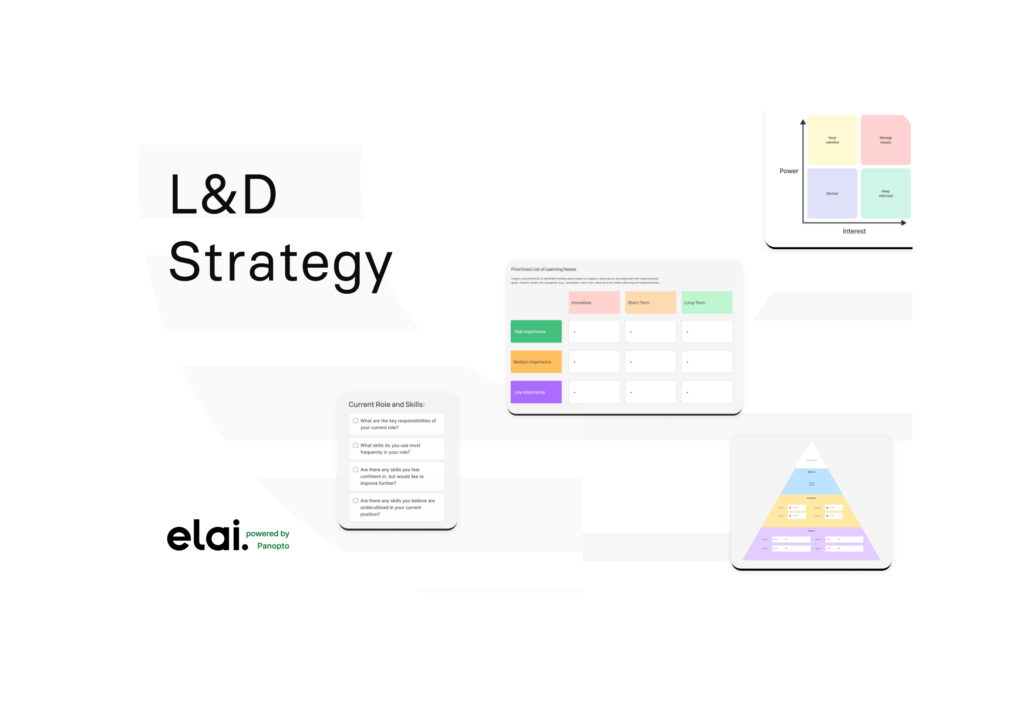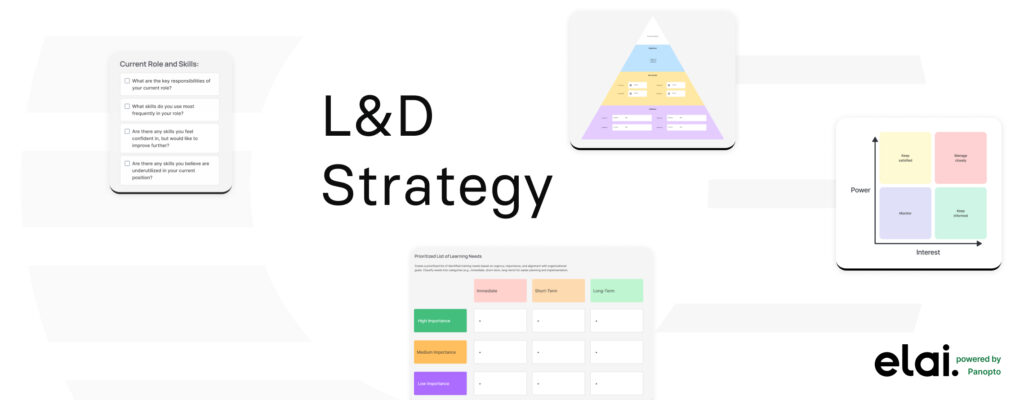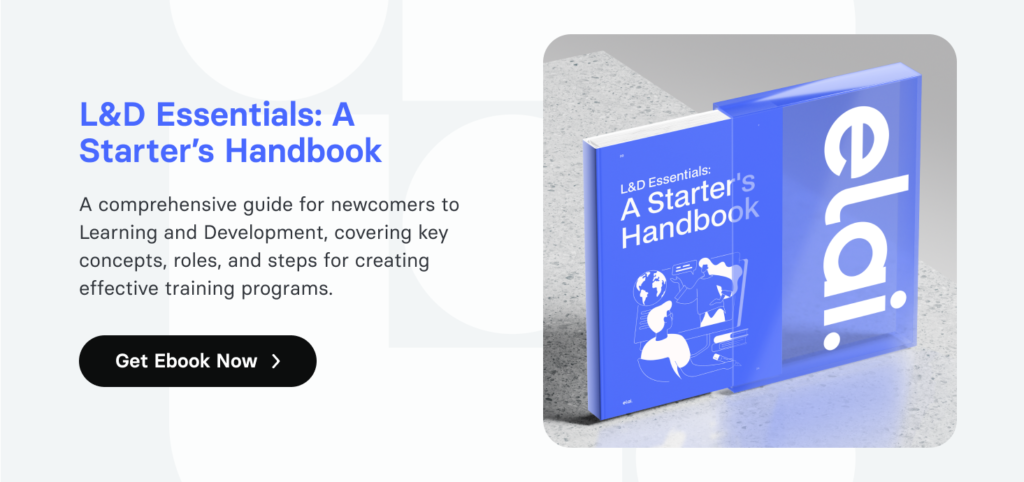Learning and Development strategy is one of the most critical aspects leading to the success of any company. Businesses may encourage creativity, raise morale, and foster a culture where people are constantly trying to do better by investing in the professional development of their workforce. Research by Deakin University together with Deloitte has shown that employee development isn’t just about expenses; it’s an investment with a powerful payoff. Every dollar spent on training can generate nearly five times that amount in increased revenue per employee.
Companies should set an efficient L&D strategy because it not only provides employees with the necessary skills and knowledge relevant to their roles but also contributes more effectively to the organization’s goals. L&D may help staff members become more proficient at solving problems and making decisions while lowering risks and making expensive mistakes by teaching them new practices and techniques. Well-trained workers can offer a business a competitive position in the marketplace since they are consistently more inventive and creative, which produces new, ground-breaking approaches. In addition, companies can reduce turnover rates and retain their top talent.
Step 1: Assessing Current L&D Practices
First and foremost, the companies must choose, assess, and apply the approach that works the most in their particular case at the beginning of their journey to building an effective Learning and Development strategy. Among all current practices, organizations should select those approaches that ensure that their training initiatives are aligned with their goals, meeting the needs of their employees, and driving overall business success.
By evaluating and assessing current L&D practices, we can distinguish the ones that work and those that don’t.
What works:
Fit business goals: L&D programs that directly support company objectives are more likely to be effective.
Engage employees: When employees feel invested in their learning, they are more likely to apply new skills and knowledge.
Foster continuous learning culture: Organizations that promote a culture of continuous learning often see better results.
Promote data-driven decisions: Using metrics and analytics to measure the effectiveness of L&D initiatives can help identify areas for improvement.
What doesn’t work:
A one-size-fits-all approach: Generic training programs may not address the specific needs of individual employees or teams.
Lack of follow-up: Without reinforcement and opportunities to practice new skills, learning may not be retained.
Insufficient resources: Insufficient funding, time, or personnel can reduce the success of L&D programs.
Disconnected from performance: If L&D programs are not linked to performance reviews or rewards, they may not be seen as valuable.
To evaluate the effectiveness of your L&D practices, companies should consider conducting a needs analysis, assessing employee satisfaction, and measuring the impact on business outcomes.
Step 2: Setting Clear Objectives for Creating an L&D Strategy
In the field of fast-evolving corporate L&D, it is important to identify and understand the clear objectives and purpose of what the organization wants to achieve. Each Learning and Development strategy example is based on a fixed company’s goals that must be relevant to internal training programs. This means figuring out where your employees are falling short and what skills they need to improve. After finding and setting coherent and transparent L&D strategy objectives, the organization can finally focus its efforts on building a productive and thriving community where resources are used wisely, and training programs are working effectively.
The right goals provide a roadmap for the company’s initiatives that will deliver tangible results in the future:
- Strategic planning in L&D starts with understanding your company’s big picture. What is its strategic plan for the next few years? What are its most important priorities?
- L&D Teams should think about the skills the employees need to achieve these goals. Are there any knowledge gaps or areas where they could use some extra training?
- It’s important to set clear, achievable, relevant, and measurable objectives.
- To stay on track, do not forget to track your progress and evaluate outcomes. Set deadlines to create a feeling of accountability and urgency.
L&D strategy 2024 brings nothing without paying attention to the specific needs of individual departments or teams, such as enhancing productivity or reducing employee turnover, customer preferences that influence revenue or improve customer satisfaction and individual-level demands, such as improving employees’ skills or advancing their careers. The company leaders should not disregard collaboration and feedback impact because these organizations prioritize and identify areas where L&D can make a significant impact. The Deloitte survey proves that around 90% of HR executives and professionals are actively trying out new approaches to skills-based practices.
Taking into consideration these aspects in strategic planning in L&D can result in higher effectiveness of the development practices the company integrates.
Step 3: Identifying Stakeholders and Their Roles in Building L&D Strategy
Corporate Learning and Development should focus on implementing technology that fits both training objectives and company goals. According to World Economic Forum research, more than 44% of employees’ current skills will be outdated in the next five years. But before seeking the best solution for building an effective L&D strategy, it is crucial to figure out who key stakeholders are and what roles they have.
Stakeholders are individuals, groups, or organizations who are interested in the success of an L&D strategy and the company’s overall development. Here are key roles and interests to know:
Executive Leader
Role: Provide strategic direction, allocate resources, and ultimately approve the L&D strategy.
Interests: ROI, alignment with business objectives, and talent development.
HR Executive
Role: Facilitate the implementation of the L&D strategy, manage training programs, and track employee development.
Interests: Effective talent management, employee satisfaction, and compliance with HR regulations.
Line Manager and Supervisor
Role: Identify training needs within their teams, support employee development, and ensure that training aligns with departmental goals.
Interests: Improved team performance, increased productivity, and employee engagement.
Employee
Role: Participate in training programs and provide feedback on their effectiveness.
Interests: Career development, skill acquisition, and growth opportunities.
Subject Matter Expert
Role: Create and deliver accurate and relevant training content.
Interests: Recognition of their expertise, involvement in the training process, and the quality of the training materials.
External Vendor and Consultant
Role: Provide specialized training services, expertise, or technology solutions.
Interests: Business relationships, contract renewals, and the successful implementation of their services.
Step 4: Designing an Efficient Framework
Building a Learning and Development strategy in 2024 might seem time-consuming and a tough task as professionals must take a lot of aspects and specs into account. The main aim is to create a productive workflow with easy-to-use resources and efficient tools to facilitate Learning and Development strategy framework creation.
To maintain their competitiveness and encourage staff development, businesses should incorporate the following effective strategies into their L&D strategy design:
- Foster a culture of learning by creating a learning environment that encourages employees to engage in continuous Learning and Development. This practice not only facilitates collaboration and knowledge exchange among employees but also motivates them to acknowledge and celebrate their achievements.
- Utilize Learning Management Systems (LMS) to streamline the delivery, tracking, and management of L&D programs. Such online self-paced learning enables employees to access learning materials anytime, anywhere.
- Personalized learning based on individual needs and preferences creates customized learning scenarios that identify and fix learning gaps by giving compelling feedback.
- Well-structured content that serves Learning and Development purposes made with Elai which interactivity features and modern content creation answers to the challenges of localisations and accessibility.
By implementing these successful practices, organizations can create an efficient and effective L&D framework that supports employee growth, drives business performance, and fosters a culture of continuous learning.
At Elai.io, we have designed Figma templates on L&D, including Learning and Development strategy template. Our ready-made templates aim to reduce the time needed for setup and documentation, allowing L&D teams to focus on the content of the strategy. Moreover, the FigJam interface provides the teams with interactive widgets to make knowledge sharing and presentation more comprehensive. L&D templates facilitate easy collaboration by offering a shared framework for team members to contribute and align on objectives. The colleagues can easily leave comments and make edits to the framework. These tailored templates provide clear formats for presenting information, making it easier to communicate plans and updates to stakeholders.

How to Create L&D Strategy with Ready-made L&D Templates?
With Elai.io’s L&D Figma templates, creating a Learning and Development strategy is as easy as pie! Here’s how to do it:
Step 1: Go to the Elai L&D Community in Figma.
Step 2: Choose the most suitable template.
Step 3: Fill in the canvas with the required information, and apply the relevant widgets with important data.
Step 4: Collaborate on a project by inviting colleagues or stakeholders to view or edit the canvas and encouraging others to add comments directly on the template.
Step 5: Finalize and use the completed canvas to guide the development and communication of your learning course.
Feel free to use our tailored templates as a groundwork for your future Learning and Development strategy presentation to the stakeholders.
Step 5: Monitoring and Evaluating the Effectiveness
Organizations must always ensure that the L&D strategy brings value to the company that’s why monitoring and evaluating the effectiveness of building an L&D strategy is crucial. Here’s how to measure its efficiency:
- Define Clear Objectives and KPIs. L&D objectives must support your organization’s strategic objectives. Set particular metrics to track progress and measure success.
- Leverage the Kirkpatrick Model. The Kirkpatrick Model provides a framework for evaluating training programs at four levels:
- Reaction: Measures learner satisfaction and perception of the training.
- Learning: Assesses knowledge and skills gained.
- Behavior: Evaluates changes in behavior on the job.
- Results: Measures the impact of training on business outcomes.
- Collect and Analyze Data through surveys, interviews, and observations to gather information. Use tools to identify trends, and insights, and compare results.
- Track and monitor developments constantly to find areas that need improvement. To guide changes, get input from management, stakeholders, and learners.
- Consider Additional Metrics such as training completion rates, employee satisfaction with L&D initiatives, ROI of L&D programs, and employee development and career progression rates.
- Leverage Technology to track learner progress, engagement, and completion rates. By monitoring employee performance, it is easier to identify their skill gaps. The collected data will show current trends and insights.
Future Trends in L&D
Since the field of Learning and Development is constantly evolving, it’s impossible to create the best L&D strategy that drives efficiency without taking into consideration the key trends shaping the future of L&D:
Personalized Learning Experience
- AI-Powered Tools for crafting learning content and scenarios based on individual needs, preferences, and learning styles.
- Adaptive Learning is driven by adjusting the pace and complexity of learning materials to match each learner’s progress and understanding.
Implementing of Learning Technologies
- VR and AR to create realistic simulations for hands-on training and skill development.
- Gamification that incorporates game-like elements into learning experiences to boost knowledge retention.
Microlearning
- Learning materials is broken down into small, digestible chunks for a better understanding.
- Mobile Learning through mobile devices enables learning anytime, anywhere.
Skills-Based Learning
- Focus on competencies by shifting from traditional job-specific training to developing in-demand skills.
- Lifelong learning with continuous skill development to adapt to rapidly changing job markets.
Social Learning
- Peer-to-peer collaborative learning via forums, groups, and knowledge-sharing websites.
- Through coaching and mentoring, students can get in touch with seasoned professionals for advice and assistance.
AI-Powered Content Creation
- Generative AI for personalized learning content creation, such as quizzes, simulations, and interactive courses.
Benefits of Using Elai.io for eLearning
As technology continues to evolve, L&D professionals and facilitators not only need to stay updated on modern trends but also adapt Learning and Development strategy examples to meet learners’ needs and preferences. This is where the all-in-one tool Elai comes in handy. This solution is designed to provide organizations and individuals with everything they need to craft engaging multilingual learning content at scale. Key benefits include:
- 80+ talking Avatars for AI-driven narration
- 75+ languages supported for global reach
- Interactive quizzes and clickable buttons
- Screen-recording option
- Wide collection of video templates
- API for personalized video creation
- Extensive library of stock Media
- SCORM export to any LMS
- Various video formats supported
- Auto-translation
- Voice-over option
- Custom Avatar creation & Voice cloning
- AI Storyboard for script writing and more!
To sum up
This guide has covered the significance of developing a successful L&D strategy for businesses in great detail. They can draw and keep top specialists, succeed over the long run, and maintain their competitiveness in the market. Companies may build a more engaged, effective, and creative workforce by dedicating time and resources to employee development.
FAQ
What is Learning and Development strategy?
A Learning and Development strategy is a roadmap that guides an organization in improving its employees’ knowledge, skills, and abilities. It outlines how the company will invest in its workforce to achieve its business goals and remain competitive.
How to create a Learning and Development strategy?
To create an L&D Strategy that works, identify skill gaps, performance issues, and future requirements, define clear, measurable learning goals that support business objectives, select suitable training methods (e.g., workshops, online courses, mentoring) based on learner needs and preferences, and create engaging and relevant training materials.

